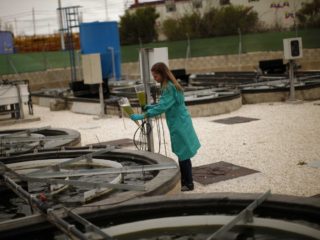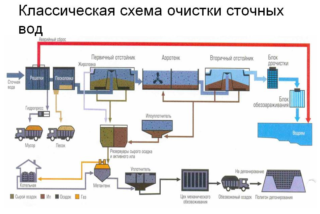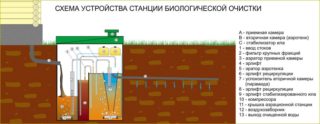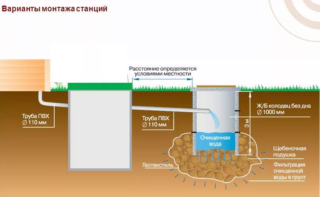Multi-apartment and private houses, enterprises and service sector establishments use water, which, after passing through the sewer mains, must be brought to the required level of purity, then sent for reuse or drained into rivers. In order not to create a dangerous ecological situation, treatment facilities have been created.
Definition and purpose
The system is designed to receive a certain amount of wastewater from the city or local sewerage system, clean it from all kinds of impurities and organic substances and then send it to natural reservoirs using pumping equipment or by gravity.
Principle of operation
During the operation of the treatment plant, water is freed from the following types of contaminants:
- organic (feces, food residues);
- mineral (sand, stones, glass);
- biological;
- bacteriological.
The greatest danger is posed by bacteriological and biological impurities. When decomposed, they release dangerous toxins and unpleasant odors. If the level of cleaning is insufficient, an epidemic of dysentery or typhoid fever can occur. To prevent such situations, water after a complete cleaning cycle is checked for the presence of pathogenic flora, and only after an examination is it drained into reservoirs.
The principle of operation of treatment facilities is the gradual separation of garbage, sand, organic components, fat. Then the semi-purified liquid is sent to sedimentation tanks with bacteria, which process the smallest particles. These colonies of microorganisms are called activated sludge. Bacteria also release their waste products into the water, so after they have disposed of organic matter, the water is purified of bacteria and their waste.
In the most modern equipment, almost waste-free production takes place - the sand is caught and used for construction work, the bacteria are compressed and sent to the fields as fertilizers. The water flows back to consumers or to the river.
Types and arrangement of treatment facilities
- Household waste is used water from apartments, houses, schools, kindergartens, catering establishments.
- Industrial. In addition to organics, they contain chemicals, oil, salts. Such waste requires appropriate cleaning methods as bacteria cannot cope with the chemicals.
- Rainwater. The main thing here is to remove all the garbage that is washed down the drain. This water is less polluted with organic matter.
In terms of the volume that the treatment plant serves, the stations are:
- urban - the entire volume of wastewater is directed to objects with a huge capacity and area; located away from residential areas or made closed so that the smell does not spread;
- LOS - a local treatment plant serving, for example, a summer cottage or village;
- septic tank - a type of VOC - serves a private house or several houses;
- mobile installations that are applied as needed.
In addition to complex structures, such as biological treatment plants, there are more primitive devices - grease traps, sand traps, grates, sieves, and sedimentation tanks.
Biological treatment station device
- mechanical;
- primary sump;
- aerotank;
- secondary sedimentation tank;
- additional treatment;
- disinfection.
At industrial enterprises, containers with reagents and special filters for oils, fuel oil and various inclusions are additionally installed in the system.
In the process of receiving waste, they are first cleaned of mechanical impurities - bottles, plastic bags and other debris. Then the wastewater is passed through a sand trap and a grease trap, then the liquid enters the primary settling tank, where large particles settle to the bottom and are removed by special scrapers into the bunker.
Then the water is sent to the aeration tank, where organic particles are absorbed by aerobic microorganisms. In order for bacteria to multiply, oxygen is additionally supplied to the aerotank. After clarification of effluents, it is necessary to dispose of the excess mass of microorganisms. This happens in a secondary sedimentation tank, where bacterial colonies settle to the bottom. Some of them are returned to the aeration tank, the excess is compressed and removed.
Post-treatment is additional filtration. Not all structures have filters - carbon or membrane, but they allow you to completely remove organic particles from the liquid.
The last stage is exposure to chlorine or ultraviolet light to destroy pathogens.
Water purification methods
- Aeration - forced saturation of wastewater with oxygen for the speedy weathering of odors, as well as for the reproduction of bacteria that decompose organic matter.
- Flotation is a method based on the ability of particles to be held between a gas and a liquid. Foam bubbles, oily substances raise them to the surface, from where they are removed. Some particles can form a film on the surface that can be easily drained or collected.
- Sorption is a way of absorption by some substances of others.
- Centrifuge is a method that uses centrifugal force.
- Chemical neutralization, in which the acid interacts with alkali, after which the precipitate formed is disposed of.
- Evaporation is a method in which heated steam is passed through the dirty water. Volatiles are removed along with it.
Most often, these methods are combined into complexes in order to carry out cleaning at a higher level, taking into account the requirements of sanitary and epidemiological stations.
Design of treatment systems
The treatment plant layout is designed based on the following factors:
- Groundwater level. The most important factor for stand-alone wastewater treatment systems. When arranging a septic tank with an open bottom, the drains after settling and biological treatment are removed into the ground, where they enter underground waters. The distance to them should be sufficient so that the liquid clears when passing through the soil.
- Chemical composition. From the very beginning, you need to know exactly what waste will be cleaned, what equipment is needed for this.
- The quality of the soil, its penetrating ability. For example, sandy soils absorb liquid faster, but clayey areas will make it impossible to dispose of wastewater through an open bottom, which will lead to overflow.
- Waste disposal - entrances for cars that will serve the station or septic tank.
- The possibility of draining clean water into a natural reservoir.
All treatment facilities are designed by special firms that are licensed to carry out such work. A permit is not required to equip a private sewage system.
Installation of installations
The quality of the work performed will determine the stable operation of the station, the durability of the equipment, therefore, public facilities need to be well designed, taking into account all the features of the area and the complete set of the system.
Stages:
- Project creation.
- Site inspection and preparatory work.
- Installation of equipment and connection of nodes.
- Setting up station control.
- Testing and commissioning.
The simplest types of autonomous sewerage require the correct slope of the pipes so that the line does not get clogged.
Operation and maintenance

Routine maintenance prevents serious accidents, therefore, at large sewage treatment plants there is a schedule according to which the units and the most significant units are regularly repaired, and parts that have failed are replaced.
At biological treatment plants, the main points requiring attention are:
- the amount of activated sludge;
- oxygen level in water;
- timely removal of garbage, sand and organic waste;
- control of the final level of wastewater treatment.
Automation is the main link that is involved in the work, therefore, checking electrical equipment and control units by a specialist is a guarantee of the station's uninterrupted operation.
Of particular importance is the power of ultraviolet lamps, which need to be periodically replaced. The purity of the water ultimately depends on their work.
The cost of treatment facilities
For a private house, you can order the most modern cleaning system, but it will be quite expensive, so the owners of several houses unite and build a local local station, which allows them to do the job efficiently, but the price of treatment facilities decreases the more the more houses are connected to one device.
It is cheaper to equip a septic tank with two chambers using plastic materials. Such a system will be cheap, but it will not be able to work on a full-fledged purification - you cannot drain water into the river.













